 最近,“凯利蓝皮书”的一项全国性调查发现,受访者对2级自动驾驶的态度最为开放,但选择时会优先考虑4级自动驾驶汽车。(图片来源:凯利蓝皮书)
最近,“凯利蓝皮书”的一项全国性调查发现,受访者对2级自动驾驶的态度最为开放,但选择时会优先考虑4级自动驾驶汽车。(图片来源:凯利蓝皮书)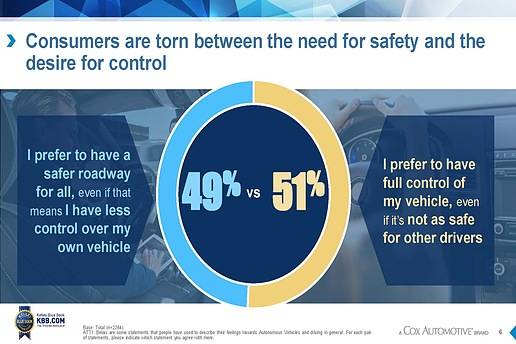 选择“社会安全”与“个人控制”的受访者人数不相上下。
选择“社会安全”与“个人控制”的受访者人数不相上下。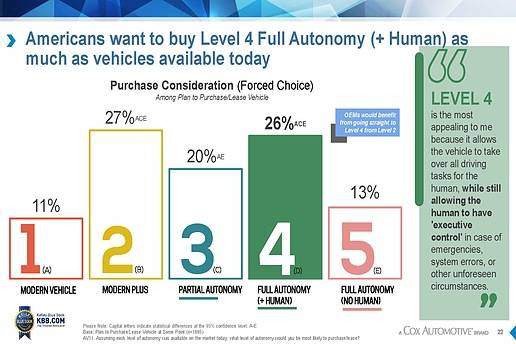 在购买意向方面,受访者认为SAE 4级自动驾驶汽车与目前市面上的SAE 2级半自动驾驶功能拥有同等的吸引力。
在购买意向方面,受访者认为SAE 4级自动驾驶汽车与目前市面上的SAE 2级半自动驾驶功能拥有同等的吸引力。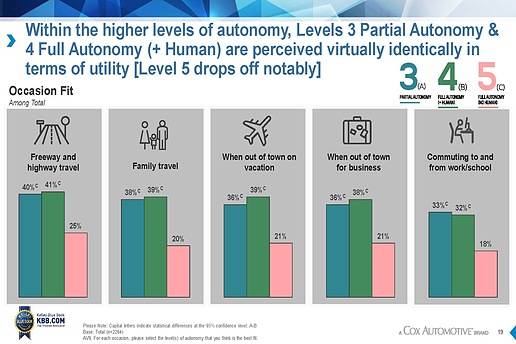 大多数人认为,在多种驾驶环境下的“实用性”方面,SAE 3级和SAE 4级自动驾驶几乎没什么区别。这两种自动驾驶级别的受欢迎程度,均高于SAE 5级全自动驾驶。
大多数人认为,在多种驾驶环境下的“实用性”方面,SAE 3级和SAE 4级自动驾驶几乎没什么区别。这两种自动驾驶级别的受欢迎程度,均高于SAE 5级全自动驾驶。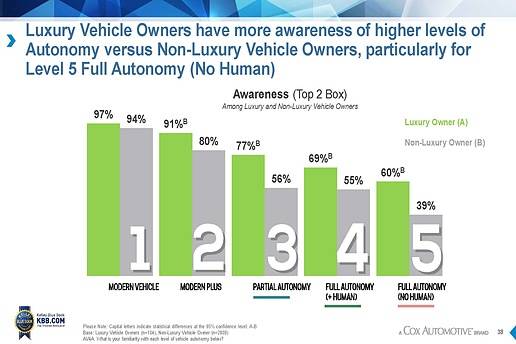 现阶段,豪华车主普遍更加了解自动驾驶技术。
现阶段,豪华车主普遍更加了解自动驾驶技术。 62%的受访者,尤其是年纪较大的受访者认为,自己不会在有生之年内看到马路上全是自动驾驶汽车的景象。
62%的受访者,尤其是年纪较大的受访者认为,自己不会在有生之年内看到马路上全是自动驾驶汽车的景象。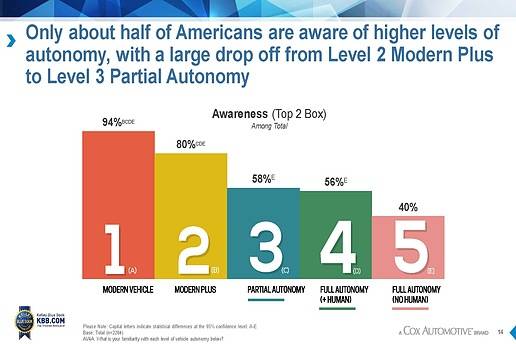 人们需要更深入地了解,科技将如何帮助SAE 5级全自动驾驶一步步实现。
人们需要更深入地了解,科技将如何帮助SAE 5级全自动驾驶一步步实现。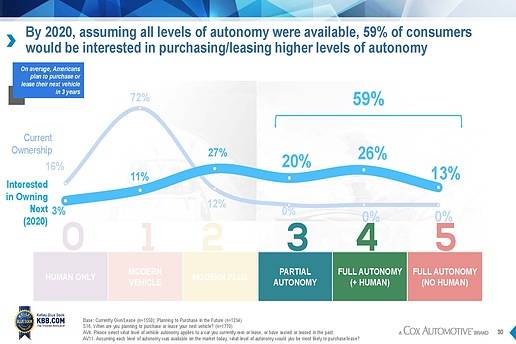 调查显示,如果各级自动驾驶汽车均可在2020年前成为现实,59%的受访者表示有兴趣购买具有更高级别自动驾驶功能的车辆。
调查显示,如果各级自动驾驶汽车均可在2020年前成为现实,59%的受访者表示有兴趣购买具有更高级别自动驾驶功能的车辆。
近日,美国汽车估价与购物网站“凯利蓝皮书” (Kelly Blue Book)公布了一项(美国)全国性自动驾驶汽车技术调查结果,报告显示尽管有半数民众对自动驾驶汽车的终极安全持信任态度,但大多数人仍认为随着自动功能的不断增加,车辆的安全性会有所下降。
《2016年凯利蓝皮书:未来自动驾驶汽车驾驶员报告》(2016 Kelly Blue Book Future Autonomous Vehicle Driver Study)显示,在2,200名受访者中,有60%的民众承认“自己对自动驾驶汽车了解甚少,甚至一无所知”,而这可能也在一定程度上影响了受访者对自动驾驶汽车安全性的客观评价。
凯利蓝皮书表示,网站开展本次挑战的主要目的是“总体了解当前消费者对各级别自动驾驶汽车的认识情况,以及存在的误解。”调查的总体结论之一为:消费者“会在‘对安全的需求’和‘对控制的渴望’之间摇摆,51%的受访者表示他们更喜欢由自己完全控制车辆,即使这意味着会给其他驾驶员带来更大危险,49%的受访者则表示愿意为大众创造一个更加安全的道路环境,即使这意味着自己必须放弃对车辆的部分控制。”
凯利蓝皮书高级分析师Karl Brauer表示,“目前还有很多民众仍不了解全自动驾驶汽车,比如自动驾驶汽车在紧急状况下将会如何反应等,但较低级别的车辆自动驾驶功能则愈加风靡。目前,很多美国人都有兴趣购买具备SAE 2级半自动驾驶功能的汽车。”
“最受欢迎奖”:SAE 4级自动驾驶
尽管大多数消费者均表示他们对自动驾驶汽车知之甚少,而且还“感觉”自动驾驶程度越高,车辆的安全性会越差,但“当要求受访者在不同级别的自动驾驶汽车中做出选择时,SAE 4级自动驾驶汽车凭借全面的自动功能配置,且不会剥夺驾驶员控制权的优势脱颖而出。”凯利蓝皮书在《报告》中补充道,“这并不奇怪,毕竟80%的受访者认为人们应有权选择是否自己驾车,64%认为他们更倾向于总是自己驾车。”
事实上,凯利蓝皮书在调查中发现,民众最感兴趣的自动驾驶功能是SAE 4级自动驾驶。受访者表示,他们认为SAE 4级自动驾驶汽车是最“两全齐美”的选择,这种车可以在驾驶员愿意时提供全自动驾驶,但控制权仍握在驾驶员手中。SAE 3级自动驾驶汽车并没有什么吸引力,驾驶员认为这种等级的自动驾驶并不能让他们完全放松。SAE 5级自动驾驶汽车的市场也不大,受访者认为这种绝对的自动设计完全剥夺了他们亲自驾车的选择权。
自动驾驶接受程度:不同年龄人群存在很大差异
尽管近三分之二的受访者均认为他们不会在有生之年看到马路上全是自动驾驶汽车的景象,三分之一的受访者更是表示,他们绝不会购买全自动驾驶汽车,但总体而言,年轻一代对自动技术普遍更加了解,态度也更加乐观。
凯利蓝皮书表示,那些年龄在12-15岁之间、尚未达到合法驾车年龄的“技术通”对自动驾驶汽车的接受程度最高,同时也“认为自己是最了解自动驾驶汽车的人。”在这个年龄段的受访者中,67%认为自己可以看到全自动驾驶汽车成为现实的那一天。
与此同时,在这个年龄段的受访者中,42%均表示自己对自动驾驶汽车比较了解,而对于年龄在51到64岁之间的受访者中,仅有1%认为自己了解自动驾驶技术。在本次调查中,年龄在12到15岁的受访者对SAE 5级全自动驾驶的态度最为放心。25到34岁之间的受访者紧随其后,该年龄段中44%的受访者称很放心自动驾驶汽车,61%表示感到自动驾驶汽车很安全。
此外,驾乘分享服务的兴起也会给自动驾驶技术的发展带来积极影响,最起码这关系到是谁在给你当司机。
“对比非驾乘分享服务的用户,驾乘分享服务的用户对‘让汽车给自己当司机’感到自在的多。”前者中有34% 这样认为,而后者则有44% 持这一观点。调查结果显示,“32%的驾乘分享用户对自动驾驶汽车有所了解,而仅有8%的非驾乘分享用户表示了解自动驾驶汽车。驾乘分享用户对SAE 4级和5级自动驾驶技术的态度也更加开放,并认为自动驾驶汽车更加安全。”
Automotive vehicle valuation and shopping website Kelly Blue Book released results of a national survey regarding autonomous-vehicle technology and found that while consumers were evenly split about the ultimate safety of roads with autonomous vehicles, most believed vehicles become less safe as autonomous capability increases.
Perhaps contributing to the perception that high levels of autonomy are less safe, 60% of the survey’s 2,200 respondents admitted “that they know little or nothing about autonomous vehicles,” KBB’s 2016 Future Autonomous Vehicle Driver Study reported.
Kelley Blue Book said it commissioned the national study “to understand current consumer perceptions and misconceptions of autonomous vehicles overall—and by each level of autonomy.” One of the survey’s most comprehensive conclusions found that consumers “are torn between the need for safety and the desire for control, with 51% of respondents replying that they prefer to have full control of their vehicle, even if it’s not as safe for other drivers, while 49% prefer to have a safer roadway for all, even if that means they have less control over their own vehicle.”
“Much is still unknown about fully autonomous vehicles, including how they would react in emergency situations, but the lower-level options are gaining steam, with many Americans interested in purchasing vehicles with [SAE] Level 2 semi-autonomous features,” said Karl Brauer, senior analyst for Kelley Blue Book.
SAE Level 4 autonomy is “sweet spot”
Although the majority of consumers not only indicated they know little about autonomous vehicles and perceive safety to be diminished as the level of autonomy increases, “when survey respondents were asked to make a choice between the different levels, SAE Level 4 autonomy hits the ‘sweet spot’ by providing all the benefits of full vehicle autonomy without stripping away the option of driver control,” KBB summarized in the survey report, adding, “This isn’t surprising, considering 80% of respondents believe that people should always have the option to drive themselves and 64% prefer to be in control of their vehicles.”
In fact, KBB’s survey found that interest in autonomous functionality peaks at Level 4; respondents indicated they believe Level 4 offers “the best of both worlds”—a vehicle that can always operate in fully autonomous mode if the driver desires, but retains option for driver control. Autonomous Level 3 did not appeal, with drivers believing they couldn’t fully relax. And extending to Level 5 autonomy, survey respondents found absolute autonomous design unconvincing because the option to drive is eliminated.
Generational trust, ride-sharing opportunity
Although nearly two-thirds of the survey respondents did not think they will live to see the roads populated exclusively by autonomous vehicles—and one-third also said they would never buy a fully autonomous vehicle—younger people, in general, are more knowledgeable about and seem more optimistic for autonomous technology.
Those in the “tech-savvy, pre-driving Gen Z (12-15 years old)” age range are most accepting of the notion of autonomy and “consider themselves the most educated about autonomous vehicles,” KBB said. And 67% of those pre-driving Gen Z respondents believe they will see fully autonomous vehicles in their lifetime.
Meanwhile, 42% of pre-driving Gen Z respondents said they’re well-educated about autonomous vehicles—compared with just 1% Baby Boomers (51-64 years old) who believe they have a good understanding of the technology. Pre-driving Gen Z respondents were the most comfortable and feel the safest among all age groups regarding SAE Level 5 full vehicle autonomy. Older Millennials (25-34 years old) were not far behind, at 44% comfort level and 61% feeling of safety.
And the relatively new-age phenomenon of ride-sharing seems to positively influence attitudes about autonomy. At least as it relates to whether someone else is driving you:
“Ride-share users are significantly more comfortable letting a vehicle drive them without their control (44%) versus non-ride-share users (34%),” KBB’s survey report summarized. “With ride-sharing users also more knowledgeable about self-driving vehicles (32% know a lot, versus 8% of non ride-sharers), they feel significantly more comfortable with the technology at Level 4 and Level 5,” and compared with respondents that don’t ride-share, feel that autonomous vehicles are safer.
等级
打分
- 2分
- 4分
- 6分
- 8分
- 10分
平均分
- 作者:Bill Visnic
- 行业:汽车
- 主题:电气电子与航空电子
